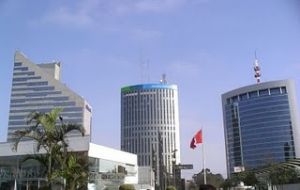MercoPress. South Atlantic News Agency
Drastic budget cuts anticipated if Brazil is to consolidate 3.3% of GDP surplus
 The Getulio Vargas Foundation is the most prestigious Brazilian think-tank
The Getulio Vargas Foundation is the most prestigious Brazilian think-tank The incoming Brazilian administration next January first will have to implement a tougher program of savings than President Lula da Silva in 2003 if the primary budget surplus is to consolidate at 3.3% of GDP in 2011, according to economists from the prestigious think-tank Getulio Vargas Foundation, FGV.
The 3.3% target announced by Finance minister Guido Mantega is expected to support the Central Bank efforts to contain the inflationary risks of the Brazilian economy which were admitted last Friday when private banks were instructed to increase their percentage of reserves deposited in the central bank. Money circulation is to be cut by 61 billion Real (approx 36 billion USD).
A team of economists from the Brazilian Economy Institute, Ibre, from FGV headed by Samuel Pessoa made a detailed projection of the necessary fiscal measures to achieve the 3.3% budget primary surplus in 2011 without appealing to ‘innovative’ accountancy. To start with the national minimum salary will only be adjusted to 540 Real (approx 320 USD) with an economy expansion of 4.9% in 2011.
Pessoa said that next year’s 3.3% primary surplus target is attainable but not politically easy, “it’s going to be extremely hard and demanding, but not impossible” and some pet projects such PAC (Program to Accelerate Growth), one of the pillars of president-elect Dilma Rousseff promises could suffer ‘containments’.
Ibre economists establish a parallelism between the fiscal efforts for 2011 with that of former Finance minister Antonio Palocci back in 2003 when President Lula da Silva first took office. The conclusion is that savings in 2011 will have to be greater, under any criteria, if the 3.3% target is to be achieved.
According to Ibre estimates the federal government share of the 3.3% whole public sector target will have to be 2.28% of GDP. This in real numbers means a great leap of 1.12% of GDP which is equivalent to a cut of 43.8 billion Real from the 2010 GDP (approx 26 billion USD).
This means the federal government should limit its layouts increase to 0.7% in real terms which is quite a challenge given the almost automatic (quasi-indexed) increase in federal expenditure pushed by the minimum national salary, the public sector salaries and by the pensions system from both the private and public sectors.
To have an idea of what this means the average annual real growth of the Brazilian federal government expenditures between 2004 and 2009 was 9% and in 2010 (election year), a walloping 11.6%.
Federal outlays increase in 2011 will then have to be less than in 2003, which was a full year of savings with the increase brought down to 1.3%. Comparing GDPs, federal expenditure will have to drop from 19.04% to 18.25% of GDP in 2011. In 2003 the pruning of federal expenditure was less, 0.58% of GDP.
Ibre points out that any fiscal adjustment in 2011 will have to cope with the fact that 77% of outlays are practically mandatory, inflexible, limiting the savings task. Ibre estimates that compared with 2010, the government could implement at the most a 0.19% of GDP savings in salaries and pensions payments. Furthermore the economists’ team estimated that for the rest of the inflexible outlays, the federal government will actually have to increase them by 0.28% of GDP.
Regarding the rest of federal expenditure targeted to a maximum of 5.36% of the 2010 GDP, it also includes some mandatory outlays such as courts sentences, the Judiciary and Legislative budgets, extraordinary credits and 4.57% of discretionary and contingent expenses.
The contribution of this sector to help the federal sector reach a primary surplus of 2.28% of GDP in 2011 means savings of 0.68% of GDP. Ibre considers this difficult to attain without slashing investments, even the PAC project, which has grown from 0.28% of GDP in 2007 to 0.7% of GDP in 2010, equivalent to 24.7 billion Real (approx 14 billion USD).
In her statements and during the electoral campaign president elect Dilma Rousseff has repeatedly said she is “against drastic fiscal adjustments such as the one of 2003”




Top Comments
Disclaimer & comment rulesCommenting for this story is now closed.
If you have a Facebook account, become a fan and comment on our Facebook Page!